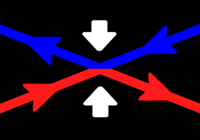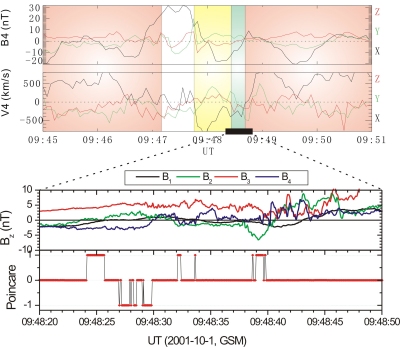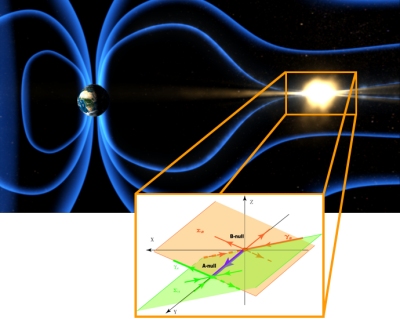Cluster unveils a new 3D vision of magnetic reconnection
29 June 2007
This week in Nature Physics, an international research team, led by Chinese scientists, reports the first observation of two linked magnetic reconnection sites using data collected by the four spacecraft of the ESA Cluster mission. This pioneering discovery will help constrain theoretical models of magnetic reconnection, a universal phenomenon in space related to star formation, solar explosions and the entry of solar wind energy into the near-Earth environment.| Animation 1. Artist's impression of a magnetic reconnection event, with passing Cluster spacecraft. (For larger versions of this video click here) |
Magnetic reconnection is a universal process in space, playing a key role in various astrophysical phenomena. On the night side of the Earth, in the magnetotail, the consequences of magnetic reconnection include the formation of intense aurora and the injection of energetic plasma particles to altitudes at which telecommunications satellites orbit. On Earth, it is the mechanism which prevents the confinement of fusion fuel, a key issue to efficiently produce electricity in controlled fusion reactors, the electricity power plants of tomorrow.
 |
| Image 1. X-line magnetic topology during magnetic reconnection |
Magnetic reconnection is the process whereby magnetic field lines from different magnetic domains collide and reconnect, leading to the mixing of previously separated plasmas. It also efficiently converts magnetic field energy to particle energy, generating reconnection jets and plasma heating (Animation 1). At the heart of the reconnection process, the magnetic field geometry forms an X shape associated with magnetic nulls (Image 1).
On 1 October 2001, the four Cluster spacecraft were flying in formation at ~110 000 km from Earth in the magnetotail, when they meandered several times around a reconnection region over a period of nearly 15 minutes. The magnetic field, plasma density and flow velocity data collected during this event have already been studied extensively under the assumption of two-dimensional (2-D) reconnection. The measured magnetic field and flow velocity (Image 2) indeed match a 2-D reconnection pattern called 2D Hall reconnection.
An international team of scientists led by Chinese researchers challenged this result under the assumption of three-dimensional (3-D) reconnection. In particular, they wanted to test theoretical results published 20 years ago, which predicted that any small perturbation to such a reconnection site would produce two magnetically linked reconnection sites, a pair of magnetic nulls (Image 3). And this is exactly what they found during a subset of the 15 minutes: a null-null line, a phenomenon never before observed in space. Their results are published in this week's online edition of Nature Physics.
To identify this null pair, the team used a recently developed method called the Poincaré index, which identifies the presence of magnetic nulls by a change of value (this index is either equal to -1, 0 or +1).
"High-resolution magnetic field data show that between 09:48:20 and 09:48:50 UT [see Image 2 bottom panel], the Poincaré index jumps up first to +1, then jumps down to -1. We may therefore conclude that two magnetic nulls were present within the Cluster tetrahedron at the two moments," wrote Dr. Xiao (Chinese Academy of Sciences, Beijing, China), Prof. Wang and Prof. Pu both from Peking University, Beijing, China, all members of the China Double Star-Cluster science team. These results have been obtained in collaboration with American and European colleagues.
Different types of magnetic nulls have been predicted by theory. Detailed analysis of the magnetic field geometry measured by Cluster around each reconnection site reveals that these two magnetic nulls are of different types, named A and B. They are magnetically connected over an A-B line, whose measured characteristics are in agreement with theoretical predictions. Its length is estimated to be 860 ± 340 km. Moreover, when reduced to 2 dimensions, this complex 3-D magnetic geometry is still consistent with past results obtained under the 2-D assumption.
Finally, the authors conclude their report by suggesting a strong candidate for what triggers this reconnection line. "It is likely that the null pair is related to lower-hybrid wave activity," wrote Xiao, Wang, Pu and co-authors. The frequency range of such waves is generally of the order of a few tens of Hz. Such an active role of lower-hybrid waves in the reconnection process is in agreement with past results found in laboratory [Carter et al., 2002] and by Cluster [e.g. Bale et al., 2003; Vaivads et al., 2004] in space.
"For the first time, a reconnection line has been observed in-situ in 3-D. This result is another major scientific achievement of the Cluster mission obtained thanks to fruitful scientific collaborations between Chinese, American and European scientists," said Philippe Escoubet, Cluster and Double Star project scientist of the European Space Agency.
Xiao, C. J., X. G. Wang, Z. Y. Pu, Z. W. Ma, H. Zhao, G. P. Zhou, J. X. Wang, M. G. Kivelson, S. Y. Fu, Z. X. Liu, Q. G. Zong, M. W. Dunlop, K-H. Glassmeier, E. Lucek, H. Rème, I. Dandouras, C. P. Escoubet, Satellite Observations of Separator Line Geometry of Three-Dimensional Magnetic Reconnection, Nature Physics advance online publication, 24 June 2007 (doi:10.1038/nphys650)
Related articles
Xiao et al., In situ evidence for the structure of the magnetic null in a 3D reconnection event in the Earth's magnetotail, Nature Physics 2, 478 - 483, 1 July 2006
Past studies on 01 October 2001:
- Runov, A. et al. Current sheet structure near magnetic X-line observed by cluster. Geophys. Res. Lett. 30, 1579, 2003
- Wilber, M. et al. Cluster observations of velocity space-restricted ion distributions near the plasma sheet. Geophys. Res. Lett. 31, L24802, 2004
- Cattell, C. et al. Cluster observations of electron holes in association with magnetotail reconnection and comparison to simulations. J. Geophys. Res. 110, A01211, 2004
- Wygant, J.R. et al. Cluster observations of an intense normal component of the electric field at a thin reconnecting current sheet in the tail and its role in the shock-like acceleration of the ion fluid into the separatrix region. J. Geophys. Res. 110, A09206, 2005
- Imada et al. Energetic electron acceleration in the downstream reconnection outflow region, J Geophys Res, 112, A03202, doi:10.1029/2006JA011847, 2007
Lower hybrid waves and magnetic reconnection:
- Bale, S.D., Mozer, F.S. & Phan, T. Observation of lower hybrid drift instability in the diffusion region at a reconnecting magnetopause. Geophys. Res. Lett. 29, 2180, 2002
- Carter, T.A. et al. Measurement of lower-hybrid drift turbulence in a reconnecting current sheet. Phys. Rev. Lett. 88, 015001, 2002
- Vaivads, A. et al. Cluster observations of lower hybrid turbulence within thin layers at the magnetopause. Geophys. Res. Lett. 31, L03804, 2004
Contact
C.J. Xiao
National Astronomical Observatories, Chinese Academy of Sciences, Beijing 100012, China
E-mail: cjxiao ourstar.bao.ac.cn
ourstar.bao.ac.cn
Z.Y. Pu
School of Earth and Space Sciences, Peking University, Beijing 100871, China
E-mail: zypu pku.edu.cn
pku.edu.cn
Web story author and co-editor
Arnaud Masson, SCI-SO division, RSSD, ESA, The Netherlands
E-mail: Arnaud.Masson esa.int
esa.int
Phone: +31-71-565-5634
Web story editors
Philippe Escoubet, SCI-SM division RSSD, ESA, The Netherlands
E-mail: Philippe.Escoubet esa.int
esa.int
Phone: +31-71-565-4564
Arnaud Masson, SCI-SO division, RSSD, ESA, The Netherlands
E-mail: Arnaud.Masson esa.int
esa.int
Phone: +31-71-565-5634
Matt Taylor, SCI-SO division, RSSD, ESA, The Netherlands
E-mail: Matthew.Taylor esa.int
esa.int
Phone: +31-71-565-8009




